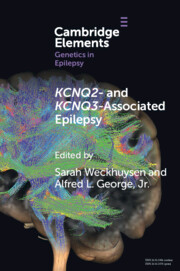Crossref Citations
This Element has been
cited by the following publications. This list is generated based on data provided by Crossref.
George, Jr., Alfred L.
Abbott, Megan
Bender, Kevin J.
Brunklaus, Andreas
Demarest, Scott
Egan, Shawn
Haviland, Isabel
Kearney, Jennifer A.
Schust Myers, Leah
Olson, Heather E.
Sanders, Stephan J.
SanInocencio, Christina
Symonds, Joseph
and
Thompson, Christopher H.
2024.
<i>SCN2A</i>-Related Disorders.
De Wachter, Matthias
Millevert, Charissa
Nicolai, Joost
Cats, Elisabeth
Kluger, Gerhard
Milh, Mathieu
Cloarec, Robin
Syrbe, Steffen
Arts, Katrijn
Jansen, Katrien
Krygier, Magdalena
Smigiel, Robert
Auvin, Stephane
Olofson, Kern
Gjerulfsen, Cathrine Elisabeth
Ceulemans, Berten
Møller, Rikke S.
Bayat, Allan
and
Weckhuysen, Sarah
2025.
Amitriptyline use in individuals with KCNQ2/3 gain‐of‐function variants: A retrospective cohort study.
Epilepsia,
Vol. 66,
Issue. 5,
p.
1628.
Abreo, Timothy J
Thompson, Emma C
Madabushi, Anuraag
Park, Kristen L
Soh, Heun
Varghese, Nissi
Vanoye, Carlos G
Springer, Kristen
Johnson, Jim
Sims, Scotty
Ji, Zhigang
Chavez, Ana G
Jankovic, Miranda J
Habte, Bereket
Zuberi, Aamir R
Lutz, Cathleen M
Wang, Zhao
Krishnan, Vaishnav
Dudler, Lisa
Einsele-Scholz, Stephanie
Noebels, Jeffrey L
George, Alfred L
Maheshwari, Atul
Tzingounis, Anastasios
and
Cooper, Edward C
2025.
Plural molecular and cellular mechanisms of pore domain KCNQ2 encephalopathy.
eLife,
Vol. 13,
Issue. ,



